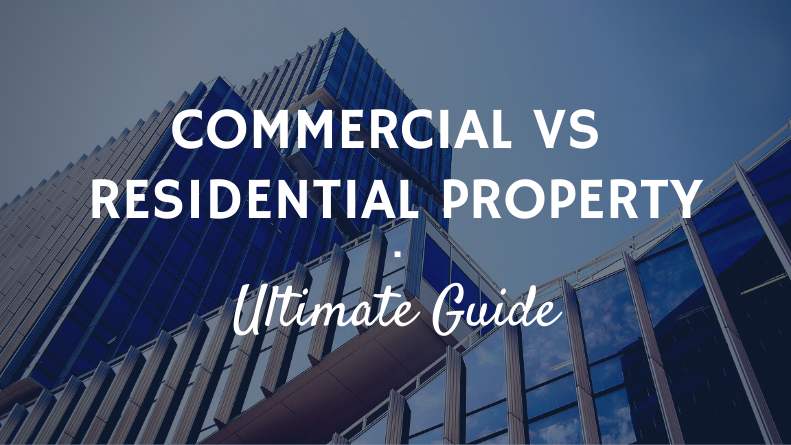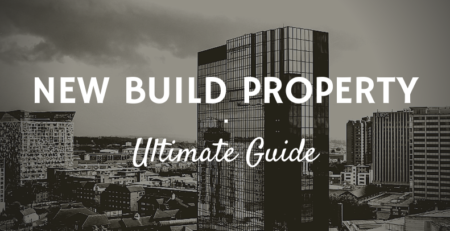Commercial vs Residential Property | Ultimate Guide
A common question posed by property investors, what is the better investment, commercial vs residential property? The answer here can depend on quite a few factors, primarily including what you are looking to get out of the investment.
We have prepared this comprehensive ‘ultimate guide’ comparing these two property types to give you a better understanding of how each investment type works, comparing the pros and cons of both to give you greater clarity over which investment is right for you.
- What is Residential Property?
- Types of Commercial Real Estate Property
- Major Themes and Trends for UK Commercial Property in 2022
- The Pros and Cons of Investing in Commercial Property
- The Pros and Cons of Investing in Residential Property
- Residential vs. Commercial Real Estate Investing
What is Residential Property?
The most common type of property for investors, residential property refers to property that is zoned specifically for living or dwelling, for individuals or households.
It’s a good idea for property investors to become familiar with the different types of UK residential property available. We in the United Kingdom are exceedingly fortunate to have a wide range of housing options available to us.
If you want to invest in property in the UK, you might be confused by the different kinds of property you can invest in. Below, we run through the common residential property types you will likely encounter in your property investment search.
Flats
Flats are the most economical home in the United Kingdom and are often regarded as the first step on the property ladder. In the UK, the cost of a flat is often lower than that of a house, making it an excellent choice for individuals and small families.
It’s no surprise that they’re called ‘flats’, given that most comprise of a single floor, where you will find all the rooms conveniently located. When you learn that there are even more subcategories under the banner of flat, things get a bit trickier.
Purpose-built flats
The concept of purpose-built flats is simple enough. Flats created with the express intention of being flats from the outset are known as purpose-built flats. A new block of flats, for example, would be purpose-built, as opposed to a large house that has been divided and compartmentalised into separate dwellings.

Flats conversions
In contrast to a purpose-built structure, converted flats are those built from an existing dwelling that wasn’t built specifically for this purpose, like a large house mentioned above.
Studio flats
It’s here that things can become a little muddled, so be careful. It’s common for one-bedroom apartments to be confused for studios, even though the genuine definition of a studio flat is distinctly different. In a studio apartment, everything except the bathroom is contained in a single room.
The typical studio flat consists of a single space that is partitioned by furniture or partial walls. In a studio flat, the kitchen, living room, and sleeping quarters are all located in the same space. A one-bedroom flat, on the other hand, will typically contain a separate bedroom from the main living space. The one thing that both have in common is a separate bathroom.
Maisonettes
Even though the name ‘maisonette’ is sometimes misunderstood, a real maisonette is defined by a single rule: it must have a separate entrance that leads directly to the outside. This means that a maisonette lacks a common interior space.
Additionally, maisonettes tend to be two-story constructions, unlike the typical one-story flat. Here, things get confusing because some purpose-built flats have two-story homes in them, but the front doors open into hallways shared with other flats.
Often referred to as ‘maisonettes’, these units don’t really open out to the exterior of the building, so they are not strictly speaking maisonettes. These are more accurately referred to as ‘split-level’ or ‘duplex’ apartments.
Bungalows
Next, we will consider the types of houses that are available in the UK to invest in.
Bungalows are typically one-story homes; however, due to loft conversions, some have been converted into two-story homes. For accuracy of definition, dormer windows must be added to a loft conversion’s sloping roof in order for it to keep its bungalow status. The term ‘Chalet Bungalows’ is often used to describe these types of homes.
As bungalows don’t rise, they tend to spread out, which means that they frequently take up more ground than a typical home would. As a result, bungalows aren’t being built in the UK any longer, so they’re usually invariably from the 20th century when they’re constructed. Furthermore, they are often quite expensive to buy due to their rarity.
Cottages
Formerly the domain of ‘cotters’, a colloquial name for agricultural labourers who were granted tenancy of the property in exchange for their services, cottages are now ubiquitous. However, instead of calling these urban homes ‘cottages’, it’s more accurate to call them ‘cottage-style’.
Terraced houses
Things are starting to become a bit more straightforward now. A terraced house is a dwelling that is part of a row of similar properties that are built in a straight line.
Terraced homes, often known as ‘townhouses’ in the United States, are a common type of home in the United Kingdom and one popular with many buy-to-let property investors. Because of their shared side walls, more residences may be built on a parcel of land than with detached or semi-detached houses.
End-of-terrace houses
The end-of-terrace property is exactly what it sounds like: the end of the terraced row of houses. It’s not uncommon to see residences at either end of a terrace with floor plans that range greatly from those in the middle, even though terrace construction will be a consistent design.
One reason why end-of-terrace houses are the more popular ones is because you’ll only have neighbours on one side, as opposed to having two on either side of you.
Semi-detached houses
Semi-detached houses are like end-of-terrace houses in that they both share one side with another house. Unlike a long row of terraced houses, a semi is only connected to one other house because it was built as a pair.
Detached houses
There are no common walls between a detached house and another property. Many people consider detached homes the most exclusive type of residence, with many people considering them the top of the housing stock.
Detached houses commonly include front and rear gardens, and some are built on even larger plots of land. They might be called something else entirely if they are very large in size, such as a mansion.
Mansions
A mansion is a palatial residence that typically belongs to a well-off individual or family. A mansion can be thought of as a term that refers to any kind of large and impressive house and does not necessarily exclusively relate to a stately home.
Basically put, the meaning of the term mansion is somewhat ambiguous, although it will always be inextricably linked to wealth and luxury.

Types of Commercial Real Estate Property
It doesn’t matter whether it’s a house or an apartment, the British people have a famous love affair with their homes. Commercial real estate has become increasingly popular because of this love of property over the years, so it’s no surprise that it’s getting more and more popular for investors looking to grow their wealth.
There are various forms of commercial property, and the first step is to learn more about these categories, so you are clear on what exactly is meant by commercial property.
The types of commercial properties
A commercial building is defined as a place where business is conducted. There are five primary sorts of commercial properties, each of which has a distinct application.
These are the five main categories:
- Offices
- Retail – retail stores, shopping centres, shops
- Industrial – warehouses, factories
- Leisure – hotels, pubs, restaurants, cafes, sport facilities
- Healthcare – medical centres, hospitals, nursing homes
Commercial real estate classifications
The Town and Country Planning (Uses Classes) Order of 1987 categorises the various types of commercial buildings and specifies the appropriate uses for each type of commercial property in question. The ‘use classes’ of commercial buildings are established by the local authorities, and if you do business in a commercial building that is not in accordance with the planning use, you might be subject to financial penalty.
Your local planning authority may demand planning approval if you want to remodel or change the building’s intended purpose. There are two major advantages to using this system of property classification:
- To decrease the number of complaints, planners for an area might guarantee that an area doesn’t include specified property categories, such as bars or night clubs.
- Determines what sort of business they are permitted to move into premises.
UK commercial property use classes
Let’s start by taking a closer look at the A-D classes of use:
A1 – Shops
You may use them for any of the following reasons:
- for the retail sale of goods but this doesn’t include hot food
- use as a post office
- for the sale of tickets or as a travel agency
- for the sale of sandwiches or other cold food for consumption off the premises
- for hairdressing
- for funerals directors
- for the display of goods for sale
- for the hiring out of domestic or personal goods or articles
- for the reception of goods to be washed, cleaned, or repaired

A2 – Financial and Professional Services
These premises can be used for the following purposes:
- financial services (e.g., building societies or banks)
- professional services (other than health or medical services)
- any other services which it is appropriate to provide in a shopping area
A3 – Food and Drink
For the sale of food and drink for consumption carried out on the premises:
- restaurants, snack bars, cafés, shops for sale of hot food
A4 – Drinking Establishments
Alcoholic beverages are sold and consumed on the grounds of these establishments:
- public houses (pubs), wine bars
A5 – Hot Food Take-away
Premises dedicated to the selling of hot meals to be consumed elsewhere.
B1 – Business
For any of the following purposes:
- offices not classified within A2 category
- for research and development studios
- for any industrial process (for example, high tech)
B2 – General Industrial
General industrial use for the carrying on of an industrial process other than one falling within class B1, or within classes B3 to B7.
B8 – Storage and Distribution
Use for:
- wholesale warehouse and distribution centres
C1 – Hotels
Use as a:
- hotel, boarding or guest house
C2 – Residential Institutions
Use for:
- boarding schools, residential colleges, and various types of training centres
- residential care homes, hospitals, nursing homes
C3 – Dwelling houses
This is made up of three sections:
Section one: use by a single person or a family (a couple whether married or not, a person related to one another, a person employed by an employer and certain domestic employees (such as an au pair, nanny, nurse, governess, servant, chauffeur, secretary, and personal assistant), a carer and the person receiving the care and a foster parent and foster child).
Section two: six or more persons in a single-family receiving care, such as in a supported housing programme for people with mental health or learning difficulties.
Section three: a group of up to six persons that share a residence together. For example, a small religious community or a homeowner who has a lodger can both fall into this category, even if they don’t meet the strict criteria of the C4 HMO classification.
F1 and D1 – Non-residential institutions
Any use that does not including residential:
- places of worship, church halls
- clinics, health centres, crèches, day nurseries, consulting rooms
- museums, public halls, libraries, art galleries, exhibition halls
D2 – Assembly and Leisure
Use as:
- cinemas, music, and concert halls
- dance, sports halls, swimming baths, skating rinks, gymnasiums
- other indoor and outdoor sports and leisure uses, such as bingo halls, casinos
Sui-Generis
“Sui-generis” is where the uses do not fall within the main classes set out above. This includes buildings like theatres, nightclubs, scrap yards, petrol filling stations, launderettes etc.
Major themes and trends in commercial property in the United Kingdom in 2022
What trends in the commercial real estate sector in the United Kingdom are most likely to emerge by the end of 2022?
Investment decisions are increasingly being shaped by structural market changes, including the effects of demography and technology on the long term as well as ESG (environmental, social, and governance) factors. Factors such as rising prices, Brexit, and the ongoing COVID influences, as well as adjusting to new business and consumer habits, are all likely to have a significant impact on the economy in 2020.
What areas will present the most appealing opportunities?
Management of assets will continue to be an important source of wealth creation in the future. A wide range of options are available, such as improving the refurbishment value of the property and attracting higher-quality tenants, altering the usage of assets to raise rental revenue; or negotiating extensions of current leases.
When looking at the real estate market in general, definitions of core and alternative real estate sectors have been revised in recent years because of the asset class’s rapid development. It’s becoming more common for investors to put their money into more defensive, income-resilient areas of the property market, as well as those that are taking advantage of positive long-term social and economic developments like the increase of internet shopping.
Diversified property portfolios are being reshaped by the rise of new and developing subsectors, such as residential, healthcare, data storage, and logistics. An important part of this change is that key stakeholders are willing to make long-term pledges to emit net zero carbon and to benefit from environmental and social programs.
Commercial property investment activity is unlikely to significantly increase until the economy stabilises to a greater degree. Due to projections for a more divergent K-shaped rebound, with certain sectors flourishing while others lag behind, this is not expected to translate to a uniform upturn in real estate performance. As a result, it is essential to be selective in discerning property investment opportunities.
The office sector will be particularly affected by how the UK’s financial services industry navigates post-Brexit laws and changes. The near-term forecast for the office sector appears to be a challenging environment, especially considering the pandemic’s impact on office space requirements.

Unless retail warehouses see a resurgence due to the increased size and spacing of the stores, retail will remain less appealing to investors. This contrasts with the industrial sector, particularly logistics, where capital investment is plentiful, supply is constrained, and land prices are on the rise. Selective assets within the alternative sector and supermarkets are also predicted to perform well.
What market risk is overlooked?
According to several experts, the pandemic’s residual effect on consumer and company behaviour is one of the most under-appreciated market risks. A good illustration of this is that all real estate asset classes are affected by an established working-from-home culture, such as the location and design of a company model.
It’s more crucial than ever to know your tenants and do a good job of managing your property’s assets. Overall, companies need to keep looking at their production and supply chain networks to make them less likely to break down in the future.
Past performance does not predict their future performance
Not all commercial property classes are created equal. Indeed, there has never been such a significant gap in performance between different types of UK commercial property. Since 2016, industrial capital values have increased by 50% on average, whereas retail shopping centres have decreased by 50% as more people turn to online for their shipping needs. The short-term gap is likely to stay, which shows how important it is to know the market’s trends and risks.
Selective possibilities exist for income investors in the UK’s commercial property asset class, which includes a wide range of property types and industries. The strength of the tenant base makes commercial real estate a good diversifier for multi-asset portfolios. A strong tenant base can withstand future economic problems and provides a steady stream of income, with rent increases that are often fixed or tied to inflation.
Conclusion: key points
When investing in commercial real estate in the UK, you can choose from many different types of properties and industries.
Demographics, technology, and environmental, social, and governance (ESG) factors are shaping the asset class.
There is little doubt that UK commercial property will continue to be seen as a diversifier for multi-asset portfolios in the face of increasing economic troubles if it has a stable and predictable tenant base.
The Pros and Cons of Investing in Commercial Property
If you’re looking to diversify your investment portfolio, commercial real estate is a great option to consider.
Because property prices aren’t typically tied to other asset classes such as cash and fixed income (such as bonds & gilts), they tend to fluctuate independently of other asset classes and aren’t typically affected by stock market volatility.
In what ways can I invest in commercial property?
Investing in commercial real estate can be done in a variety of ways, including:
- Direct investment
- Direct commercial property funds
- Indirect property funds
Direct investment
Direct investment in property implies purchasing the entire property or a significant portion of it. For most private individuals looking to invest and grow their wealth, this may not be a viable method to obtain a taste of the commercial property sector as the investment entry barrier can be quite high.
Direct commercial property funds
Sometimes known as bricks-and-mortar funds, direct commercial property funds are more commonly invested in commercial property via a collective investment vehicle such as an open-ended investment company (OEIC), a unit trust, or an investment trust.
These types of investment funds enable access to commercial real estate investments, such as shopping centres and office buildings, which are out of reach for most small investors.
Indirect property funds
Indirect property funds invest in collective investment vehicles that invest in publicly traded property companies listed on the stock market.
Property shares can rise and fall in value in tandem with stock markets, so they don’t provide the same level of diversification as a traditional investment in real estate.
Commercial property investment funds
For many investors, commercial real estate can be a simpler and less expensive option than residential real estate. A lot comes down to your personal circumstances, financial resources, and investment strategy.
It’s hard for smaller investors to buy commercial buildings altogether since they often cost millions of pounds to acquire or develop.
As a result, most commercial real estate investors use investment funds like unit trusts, OEICs, or investment trusts to make their investments.
Investors in these funds can benefit from the rise in property values and rental revenue of the properties that they hold, or by investing in property-related firms that pay out dividends.
Investments in property funds can be made with as little as £500. Commercial real estate may be divided into three types:
- Properties devoted to retail, such as shopping malls, superstores, retail warehouses, and traditional brick-and-mortar high street stores
- Office space property, which is common practise to add high-speed internet and other services to office property, which is specifically designed to house businesses.
- Industrial property, such as warehouses.
Why might commercial real estate be a smart investment choice?
In comparison to mainland Europe and the US, the UK has much more favourable leasing arrangements, which investors find attractive. London offices often have lease terms of between 10 and 15 years, but the average lease term across the United Kingdom is eight years.
This is a far cry from the six-month to a year lease you’d typically find in a residential property buy-to-let.
Because the income is guaranteed to remain at a certain level for a lengthy period, this structure may provide more security than traditional investment vehicles like stocks.
When it comes to commercial real estate, what are direct or “bricks and mortar” commercial property funds?
As the name suggests, investing in commercial real estate through a “bricks-and-mortar fund” means that the fund buys the physical property.
One property may be vacant (and hence generating no rent), but the fund’s other properties may be able to provide revenue if one is underperforming. This type of commercial property investment is a good way to spread risk.
The combined valuation of the properties in the fund, combined with the rental revenue, are the primary sources of your returns with this investment vehicle.
Annual returns derive from the rental income generated. When you sell your investment, you may expect to get your initial investment plus any rise in the value of the properties that are part of it.
What are the advantages and disadvantages of direct commercial property investment funds?
Direct property funds can provide stable rental income due to features such as extended lease terms (usually five years or more), less risk of default than residential properties, and upward-only rent reviews, which means that rental revenue grows by at least inflation annually.
Because the manager of your fund takes care of the property management side of the investment, you don’t have to worry about it. This type of hands-off commercial investing suits many investors. The fund’s management oversees getting new tenants, buying high-quality real estate, and negotiating long-term leases.
Investors need to bear in mind, however, that commercial property markets are very illiquid compared to most other financial markets, so it might take months to acquire or sell a property, making it difficult to immediately sell your stake in the fund.
Direct commercial property investment funds can contain a lock-out clause
A lot of direct property fund investors were unable to get their money out of the fund when the 2008 financial crisis (GFC) hit the global economy.
A little-known rule in property funds permits fund managers to stop making payments to investors who want to withdraw from the fund if “exceptional circumstances” arise.
To pay back investors who want their money back, property funds are allowed to halt trading for 28 days while they attempt to raise cash under Financial Conduct Authority guidelines.
It is possible for the fund to repeat this 28-day period until it has adequate cash to fulfil redemptions, and some moratoria on people leaving funds lasted if 12 months during the financial crisis of 2007-08.
Indirect commercial property funds
Using unit trusts and OEICSs to buy shares in real estate companies is a common way for these funds to invest. Unlike direct commercial property funds, these shares are listed on the stock exchange and traded daily, so they don’t suffer from the same liquidity issues as direct commercial property funds.
Instead of immediately benefiting from rising property values and rental revenue, investors earn returns through the share price increases and dividend income common to all stock investments. Trading in an equity-like instrument provides the liquidity you need, but it also comes with the risk and reward uncertainty that comes with stock market investing.
Real estate investment trusts
More than 80% of these property firms are classified as Real Estate Investment Trusts (REITs) and enjoy larger tax advantages than other publicly traded property corporations.
REIT firms benefit by not having to pay corporation tax on their assets on the condition that 90 percent of earnings are given to shareholders as dividends, which, in turn, might entail bigger pay-outs. REITs’ owners pay either 20 percent or 40 percent tax because they’re categorised as property-letting income.
Property investment trusts
As an alternative to real estate investment trusts, you might invest in property investment trusts, which would combine your money to acquire property and property business shares.
Unlike REITs, they are treated like any other company, and dividends above £2,000 are taxed at 8.75 percent for basic-rate taxpayers in the 2022-23 tax year. For higher and extra rate taxpayers, this rises to 33.75 percent and 39.35 percent, respectively.
The Pros and Cons of Investing in Residential Property
As the UK real estate market continues to rise, an increasing number of people are contemplating residential investments. Given that the average UK house price is now over £320,000 and the average monthly rent exceeds £1,000, it’s no wonder that residential real estate is becoming increasingly popular for investors looking to grow their wealth.
That being said, there are several factors to consider before making an investment in residential real estate. While the short and long-term profits might be competitive, maintaining a residential property can be time-consuming and come with a slew of obligations.
What are the types of residential property?
Buy-to-let is the most popular choice for investors when investing in residential property. The potential for regular rental income, as well as the benefits of capital growth on the property accrued over however years you own the property means that renting out a property is a popular choice. However, it’s important to remember that there will be void periods when you don’t have a tenant in situ, and you’ll also be responsible for covering the costs of any property maintenance or repair work.

Flipping property is another popular residential property investment technique. A flip is the process of investing in property, carrying out any of the necessary repairs or renovations, and then selling it often at a profit. This can be a great way to make money in the short term, but it’s important to understand the risks involved in attempting a successful flip. Having the necessary skills or having a plan for someone to carry put the works beforehand is a must.
What Are the Advantages of Residential Property Investing?
Good long-term returns
Buy-to-let investing is typically motivated by a desire for profit and to grow one’s wealth. At a time of high inflation, this makes even more sense. Because of this reason, buy-to-let property has been a popular investment over the years. Investors can get higher long-term returns from both the monthly rent income and the capital appreciation on the property.
The money you make from renting out a property as part of a buy-to-let venture may be put to many different uses. For example, you may use it to supplement your income or use it to grow your investment portfolio. If you’re putting money into a ‘rainy day’ fund to meet unexpected or even anticipated expenses, or if you’re reinvesting your dividends, they can help you enhance your wealth.
During the time you retain the investment property, you can slowly accrue a profit from rental revenue as well as the potential for capital growth. With UK property prices rising month-to-month, there is a greater chance to reap the benefits of capital growth on a property.
Enhanced flexibility
Property is a more flexible asset than alternative investment classes. Investors can choose from several types of residential property, as outlined in the section above on property types. This gives investors a better chance of making money on their investments.
To illustrate this point, consider the option between flats and homes; both residential property types have distinct advantages that allow investors to select the asset that best fits their financial strategy. It’s critical to think about which of these two forms of real estate would best serve your financial objectives because of the differences in demographics, rental yields, and growth rates between the two.
Diversification is another benefit of investing in residential real estate. Indeed, those who want to diversify their financial portfolio might do so by investing in property alone. It is possible to lessen the impact of market swings by diversifying one’s real estate holdings among several types of properties and/or geographic regions.
What are the Cons of Residential Property Investing?
Taxes
As with any type of investment, investing in residential property comes with its own set of tax implications. If a BTL investment, should the rental income you get from your investment property exceed your yearly personal limit of £12,800, you will be subject to income tax. Even though this automatically affects your annual earnings, this remains an important factor for all types of investment asset classes.
The length of time you plan to keep real estate as an investment is something you probably already know. You’ll also have to give thought to capital gains tax if you decide to sell the property at the conclusion of this period.
Even though the rates change according to your tax bracket, you may expect to pay 18 to 28 percent of your properties profit in taxes.

Responsibilities
Another consideration should you be investing in residential property with a view of renting the property out, investors have different investment strategies based on their personal circumstances and financial goals; some prefer a totally hands-on approach while others prefer to hire a management company to manage their properties.
No matter how involved you choose to be, owning buy-to-let real estate comes with a slew of duties. One of the most critical considerations for landlords is insurance. If a renter is unable to pay their rent for whatever reason, landlords’ insurance will protect you financially.
A landlord’s obligations don’t end with insurance and finances; there are a slew of property-related ones as well. As a hands-on landlord, you’ll have to deal with everything from finding and vetting tenants to maintaining the property yourself.
Property management services are perfect for people who like to stay out of the way. The passive income will be lower, but the level of responsibility will be much lower because of this decision.
Property is a great long-term investment because of its competitive returns and greater portfolio flexibility, which offset the limitations of other assets. Investing in residential real estate has costs and obligations, but the positive performance of this asset class over the last decade and its bright prospects more than make up for these drawbacks.
Residential vs. Commercial Real Estate Investing
There are certain similarities between investing in commercial and residential properties, but there are also significant differences that you need to be aware of. Investors in these different types of real estate should be aware of the variations in risk, return, income, and capital requirements.
The advantages of residential real estate investing
- Property management is usually easier
- Benefits from taxation
Property management is usually easier
There are advantages and disadvantages to owning residential property, depending on the circumstances. For example, residential real estate is typically far easier to manage compared to commercial real estate, depending on your investment strategy and the type of investment vehicle you choose. An apartment or house with only a few residents is far easier to manage than a warehouse with dozens or even hundreds of tenants.
Many residential property landlords prefer to have a hands-on investment approach and hiring property managers may not be essential for landlords who own fewer than a handful of residential properties.
The landlord can easily take care of things like rent collection, tenant sourcing, upkeep, and repairs. On the other hand, a property manager may be required if the investor has a greater number of residential properties that are too much for him or her to handle on their own. Again, it depends greatly on the circumstances, like how close the properties are to where the landlord lives and how much time they have on their hands.
Benefits from taxation
Investing in real estate offers various tax advantages to landlords, regardless of whether they own a home or a business. Rental revenue, mortgage interest, property management fees, and depreciation may all be deductible for property owners who have tenants.
Drawbacks to residential real estate investing
Tenant turnover can be more frequent
Leases for residential properties can range from 12 to 24 months, as well as a set period of 90 days to a month-to-month agreement with no end date. Families, friends, roommates, and individuals are the most common tenants of residential leases, although sometimes corporate clients can be found.
Investment in residential real estate often entails renting out one’s personal residence with a strong emotional attachment; therefore, there is a more emotional component that you don’t typically find with commercial real estate.
Commercial property, on the other hand, is often rented out to businesses and is more legal and transactional in nature and far less personal. Families and individuals who rent residential property may be more likely to neglect the property if they only have six- or 12-month contracts in place.
Residential landlords can help mitigate this risk by nurturing a healthy relationship with their tenants and making their lives as comfortable as possible. Tenants that sign long-term leases are also more likely to adhere to the rules of the property and ensure it is well looked after.
The advantages of commercial real estate investing
- Tenant turnover is usually lower
- Benefits from taxation
Tenant turnover is usually lower
Businesses are the most common tenants in commercial properties, where lengthy leases can run up to ten years or more. Business tenants who care about the image of their business are more likely to treat a property with respect and to keep it in good repair.
Because commercial leases typically last for a longer duration, it is possible to include an escalation provision into the lease agreement that compels the tenant to pay a portion of the increased expenses of the building (such as operating expenses, real estate taxes, etc.). All of these expenses are on top of what the tenant is already paying each month in rent.
Benefits from taxation
Commercial property owners get similar tax benefits to those enjoyed by residential landlords. Depreciation, property management charges, interest on a mortgage and several other expenditures linked to a commercial property may be deductible by the owner.
The drawbacks of commercial real estate investment
- Management of commercial real estate
- Zoning
Management of commercial real estate
Commercial property management may be a daunting task when done alone. Because commercial properties have more units and more complex repair demands, collecting rent and coordinating repairs/maintenance requests is far more difficult and time-consuming, as well as subject to more regulation. To maintain long-term relationships with tenants and avoid repeated evictions, it is common practise to enlist the services of a property manager when purchasing commercial real estate.
Zoning
Commercial zoning has more categories than residential zoning, hence the regulations governing it are more in depth and complex. Regulations are based on the property’s commercial purpose and, frequently, the number of customers the business expects. It is possible to zone land that might be used for commercial purposes if it has the potential to be developed. Ordinances can say, for example, how many parking spots are needed in a business area or how many of the same kind of businesses can be in the area.
Further considerations
- Price of the property
- Income potential
- Length of the lease
- Maintenance costs
- Triple Net Lease
Price of the property
Residential buy-to-let homes are often less expensive to buy than commercial buildings. And for this reason, if you don’t have the cash up front, investing in commercial real estate becomes more challenging.
On the other hand, it’s true that when it comes to commercial real estate investments, you don’t need to acquire the entire building. As we’ve already said, commercial property funds can be used to buy stocks on the market without a big initial investment.
Income potential
Commercial property’s return on investment (ROI) is probably its most significant advantage. Commercial real estate tenants tend to expend more since they are company owners or corporations rather than families and individuals. On the other hand, the residential rental market in the UK is consistently strong due to several factors, such as a vibrant UK economy, chronic housing shortage, and high demand for rental properties.
Length of the lease
Residential leasing agreements are typically 12 months long. Even if your renters are satisfied with the property and service, there’s always the possibility that your revenue will be disrupted if they move on. To avoid disrupting their business activities, commercial renters are more inclined to sign long-term leases of three or five years or more.
The flip side of longer leases is that if you’re looking to get out of a long-term contract, you’re going to have a more difficult time doing it. So, if things aren’t going so well with your commercial tenant, you’ll need a strong reason to get them out; unlike with a residential property, you can’t just wait out the contract for a year.

Maintenance costs
The expense of property maintenance must be factored into the total cost of ownership. As you start out, you’ll likely have to spend money to fix everything from carpets to walls to doors and windows.
In the case of residential tenants, it’s not as easy to pass along the cost of repairs due to laws that favour tenants’ interests. The most recent information shows that landlords spend an average of £3,000 a year on repairs for each property.
However, you may be able to save money on your rental property’s maintenance and repair costs with good landlord insurance cover.
Triple Net Lease
When it comes to renting commercial property, there’s a form of lease known as a ‘Triple Net Lease’, in which the tenant is responsible for paying the landlord for the costs of property tax, building insurance and upkeep. Because this type of lease can be available to commercial landlords, signing one with a tenant can lower the cost of property maintenance.
A business property’s maintenance would be far more difficult and expensive if it didn’t have one of these contracts in place. Depending on the agreement you have with your renter, an on-site property manager may be necessary.
Conclusion
To conclude, there are a great number of considerations to be aware of when choosing to invest in property. Both residential and commercial property offer a range of benefits and drawbacks that investors should be acutely aware of before investing in either asset class.
Ultimately, whether you choose to invest in residential or commercial property, or a combination of both, will depend on your own goals and objectives. Whilst the entry barriers and relative ease to investing in residential property might be preferable, there is potential for success when investing in commercial property.
ARE YOU READY TO START INVESTING?
Subscribe to our mailing list now for exclusive deals, investment guides and the latest information from the property market.







